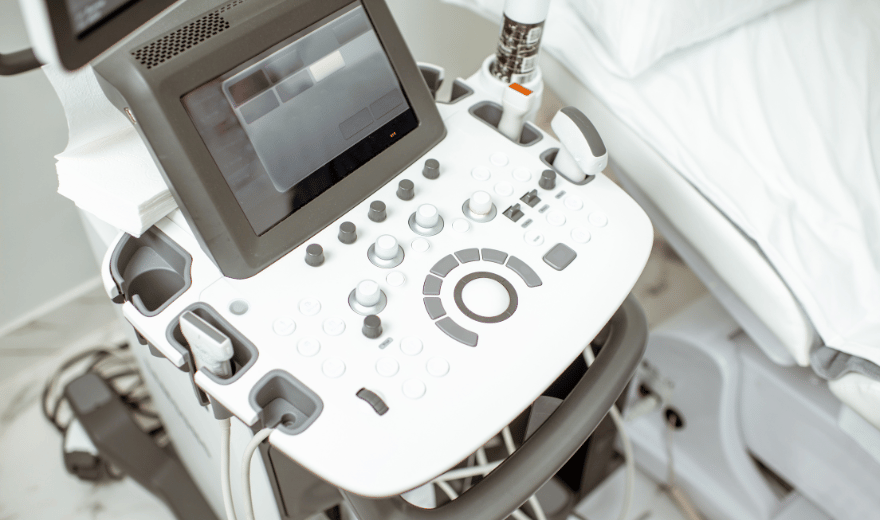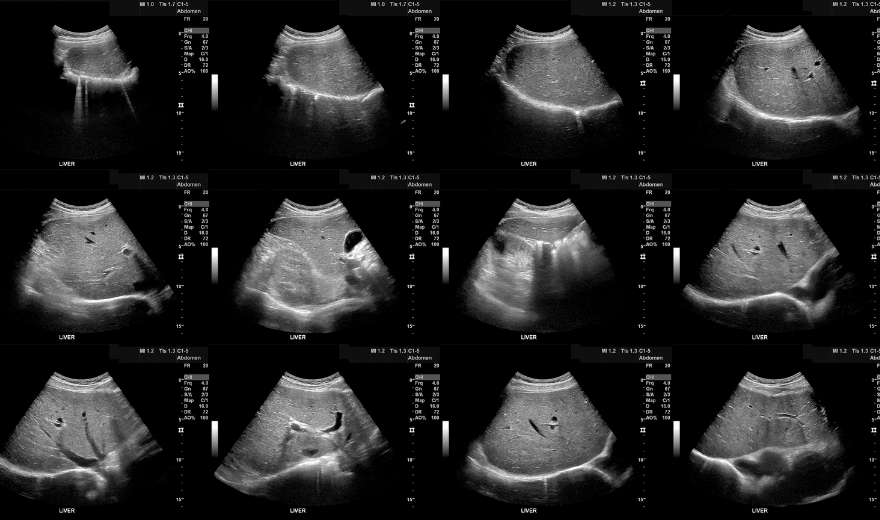
WHAT IS PELVIC ULTRASOUND IMAGING?
Pelvic ultrasound or sonography involves the transmission of sound waves into the body. Those sound waves are reflected off the internal organs. The reflections are then recorded by special instruments that subsequently create an image of anatomic parts. No ionizing radiation (x-ray) is involved in ultrasound imaging.
For women, pelvic ultrasound is most often used to examine the uterus and ovaries and, during pregnancy, to monitor the health and development of the embryo or fetus. In men, a pelvic ultrasound usually focuses on the bladder and the prostate gland. Ultrasound images are captured in real-time, so they can show movement of internal tissues and organs, such as the flow of blood in arteries and veins.
WHAT ARE SOME COMMON USES OF THE PROCEDURE?
For women, ultrasound examinations can help determine the causes of pelvic pain, abnormal bleeding, or other menstrual problems. Ultrasound images can also help to identify palpable masses such as ovarian cysts and uterine fibroids, as well as ovarian or uterine cancers.
In men, pelvic ultrasound is a valuable tool for evaluating the prostate gland, as well as for evaluating the seminal vesicles.
A pelvic ultrasound exam can help to identify stones, tumors and other disorders in the urinary bladder in both men and women
HOW SHOULD I PREPARE FOR THE PROCEDURE?
You should wear comfortable, loose-fitting clothing for your ultrasound exam. For transabdominal imaging of the pelvis, you will be asked to drink up to six glasses of water two hours prior to your exam, so that your bladder is full when the scan begins. A full bladder helps with visualization of the uterus, ovaries and bladder wall. For transvaginal examinations, no bladder filling is required.
HOW DOES THE PROCEDURE WORK?
Ultrasound imaging is based on the same principles as the sonar used by bats, ships at sea, and anglers with fish detectors. As a controlled sound wave bounces against objects, its reflected waves can be used to identify how far away the object is, how large it is, its shape and its internal consistency (fluid, solid or mixed).
The ultrasound transducer functions as both a loudspeaker (to transmit the sounds) and a microphone (to record them). When the transducer is pressed against the skin, it directs a stream of inaudible, high-frequency sound waves into the body. As the sound waves echo back from the body’s fluids and tissues, the sensitive microphone in the transducer records the strength and character of the reflected waves. With Doppler ultrasound, the microphone captures and records tiny changes in the sound wave’s pitch and direction.
These signature waves are instantly measured and displayed by a computer, which in turn creates a real-time dynamic picture on the monitor. Still frames of the moving picture are “frozen” to capture a series of images. These “frozen” images are used to obtain measurements and to document the essential positions of the examination.
Doppler ultrasonography is an application of diagnostic ultrasound to detect moving blood cells in vessels and measure their direction and speed of movement. The Doppler effect is used to evaluate movement by measuring changes in the frequency of the echoes reflected from moving structures.
WHAT WILL I EXPERIENCE DURING THE PROCEDURE?
Ultrasound imaging of the pelvis should be painless. With transabdominal ultrasound, you will lie on your back on an examining table. The radiologist or sonographer will spread some gel on your skin and then press the transducer firmly against your body, moving it until the desired images are captured. There may be varying degrees of discomfort from pressure as the transducer is moved over your abdomen, especially if you are required to have a full bladder.
With transvaginal ultrasound, although the examination is often performed to look for a cause of pelvic pain, the sonogram itself should not be painful or significantly increase your discomfort. A vaginal sonogram is usually more comfortable than a manual gynecologic examination.
Transrectal ultrasound examination of the prostate is similar in discomfort to a rectal exam performed by your doctor.
Almost all examinations take less than 30 minutes.
WHAT ARE THE BENEFITS VS. RISKS?
Benefits
- Ultrasound imaging is a non-invasive (no needles or injections, in most cases), usually painless examination.
- Ultrasound is widely available and easy to use.
- Ultrasound uses no ionizing radiation, and is the preferred image modality for diagnosis and monitoring of pregnant women and their unborn infants.
- Pelvic ultrasound can help to identify and evaluate a variety of urinary and reproductive system disorders in both sexes, without even the minimal risks associated with x-ray exposure.
- Ultrasound can visualize structure, movement and function in the body’s organs, blood vessels, and the growing fetus.
Risks
For standard diagnostic ultrasound there are no known harmful effects on humans.
WHAT DOES THE EQUIPMENT LOOK LIKE?
The equipment consists of a transducer and a monitoring system. The transducer is a small, hand-held device that resembles a microphone. The radiologist or sonographer spreads a lubricating gel on the patient’s lower abdomen, where the uterus and ovaries are located, and then presses this device firmly against the skin. Transvaginal ultrasound uses a wand-like device that is covered, lubricated and inserted into the vaginal canal.
The ultrasound image is immediately visible on a nearby screen that looks much like a computer or television monitor. The radiologist or sonographer watches this screen during an examination and captures representative images for storage. Often, the patient is able to see the monitor as well.
HOW IS THE PROCEDURE PERFORMED?
There are three methods of performing pelvic ultrasound: abdominal (transabdominal), vaginal (transvaginal, endovaginal) in women, and rectal (transrectal) in men. The same principles of high-frequency sound apply in each technique.
For the transabdominal approach, the patient has a full urinary bladder and is positioned on an examination table. A clear gel is applied to the lower abdomen to help the transducer make secure contact with the skin. The sound waves produced by the transducer cannot penetrate air, so the gel helps to eliminate air pockets between the transducer and the skin. The sonographer then presses the transducer firmly against the skin and sweeps it back and forth to image the pelvic organs. Doppler sonography can be performed through the same transducer.
Transvaginal ultrasound involves the insertion of the transducer into the vagina after the patient empties her bladder and is performed very much like a gynecologic exam. The tip of the transducer is smaller than the standard speculum used when performing a Pap test. A protective cover is placed over the transducer, lubricated with a small amount of gel, and then inserted into the vagina. Only two to three inches of the transducer end are inserted into the vagina. The images are obtained from different orientations to get the best views of the uterus and ovaries. Doppler sonography can be performed through the transvaginal transducer. Transvaginal ultrasound is usually performed with the patient lying on her back and with her feet in stirrups as during a gynecologic exam.
The prostate gland is located directly in front of the rectum, so the ultrasound exam can be performed transrectally. A protective cover is placed over the transducer, lubricated, and then placed into the rectum so the sound need only travel a short distance. The images are obtained from different orientations to get the best view of the prostate gland. Ultrasound of the prostate is most often performed with the patient lying with his left side down on the table and with his knees bent up slightly toward the chest.
Each method has its advantages. The transabdominal approach offers an expanded view of the entire pelvis, showing where one internal structure is in relation to another. Since the transducer is brought closer to the area being examined in the transvaginal and transrectal approaches, improved visualization may be achieved. Thus, it can be helpful in locating the embryonic heartbeat in an early pregnancy, evaluating the uterine texture, or measuring a cyst in an ovary. Your physician or radiologist will decide whether one or a combination of approaches is best for your particular case.
When the examination is complete, the patient may be asked to dress and wait while the ultrasound images are reviewed. Often, though, the sonographer or radiologist is able to review the ultrasound images in real time as they are acquired, and the patient can be released immediately.
WHO INTERPRETS THE RESULTS AND HOW DO I GET THEM?
A radiologist (a physician experienced in ultrasound and other radiology examinations) will analyze the images and send a signed report with his or her interpretation to the patient’s personal physician. The patient receives the ultrasound results from the clinician or referring physician who ordered the test.
WHAT ARE THE LIMITATIONS OF PELVIC ULTRASOUND IMAGING?
Ultrasound waves are reflected by air or gas. Therefore, ultrasound is not an ideal imaging exam for the bowel. Barium exams and CT scanning may be the methods of choice for bowel-related problems.
Ultrasound has difficulty penetrating bone and can only see the outer surface of bony structures and not what lies within and beyond. For visualizing bone or internal structure of certain joints, other imaging modalities, such as MRI (magnetic resonance imaging), may be selected.
continue reading
Related Posts
Do not wear deodorant, talcum powder, or lotion under your arms or on your breasts on the day of the exam. These can appear on the x-ray film as calcium spots.
Ultrasound imaging, also called ultrasound scanning or sonography, involves exposing part of the body to high-frequency sound waves to produce pictures of the inside of the body.
An abdominal ultrasound image is a useful way of examining internal organs, including the liver, gallbladder, spleen, pancreas, kidneys, and bladder.



